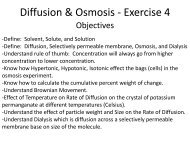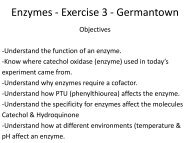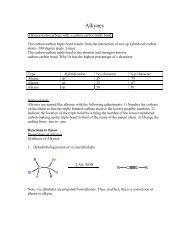Cellular Respiration Gerbil Metabolism - Science Learning Center
Cellular Respiration Gerbil Metabolism - Science Learning Center
Cellular Respiration Gerbil Metabolism - Science Learning Center
You also want an ePaper? Increase the reach of your titles
YUMPU automatically turns print PDFs into web optimized ePapers that Google loves.
• The heat is retained in part because of anatomical adaptations<br />
that reduce heat loss across the body surface. Some heat<br />
conserving adaptations include the evolution of fur, hair, feathers,<br />
and the deposition of fat near the body’s surface. These<br />
anatomical adaptations, along with a temperature detecting and<br />
regulation “thermostat” in the hypothalamus of the brain, enable<br />
certain animals to maintain a constant body temperature. Such<br />
animals are called homeotherm or endotherm these are birds,<br />
mammals, and the tuna fish species. All of the other animals are<br />
poiklotherms or ectotherm they are unable to maintain a constant<br />
internal body temperature. They cannot retain the heat that they<br />
produce, and their body temperature will fluctuate as the<br />
environmental temperature fluctuates.<br />
• Hemeothermic animals will regulate their product of heat<br />
(generate more when it is cold and less when it is hot) to maintain<br />
a constant body temperature despite fluctuations in the<br />
environmental temperature. Since the heat is produced from the<br />
chemical reactions of cellular respiration, the rate of cellular<br />
respiration is tried, in part, to thermoregulation (regulation of<br />
body temperature).







